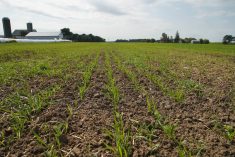Winter canola has never particularly caught on in southwestern Ontario.
But now researchers at Agriculture and Agri-Food Canada’s Research and Development Centre in Harrow are giving farmers the knowledge and tools to elevate the oilseed in this province.
A June 21 event at the research station highlighted how producers can incorporate winter canola into their crop rotations. Researchers touched on the pros, cons, dangers, and delights of growing the crop, and their overall message was clear — canola can be a profitable and environmentally beneficial overwintering crop, provided growers understand the importance of good timing. It can also give growers the option of double cropping, especially with soybeans, depending on time of harvest.
Read Also

Senft to step down as CEO of Seeds Canada
Barry Senft, the founding CEO of the five-year-old Seeds Canada organization is stepping down as of January 2026.
Why it matters: Winter canola can generate extra cash for producers during a time when many fields sit empty. It can also fit into standard rotations.
The project overall
A team of researchers at the Harrow station compared the overwintering and yield success of four winter canola hybrids in the 2016-17 season, and three during the current 2017-18 season. Each variety was separated into different planting groups. Those groups were planted at different intervals between Sept. 1 and Oct. 17 each year.
Eric Page, the main Agriculture and Agri-Food Canada researcher behind the project, said winter canola has been around in Ontario for a long time, but farmers have been slow to adopt it. This project, he said, is designed to show them how it can add value.
Benefits of winter canola
Winter canola offers a decent economic return. In a summary report from the Ontario Canola Growers Association, Page said the 2016-17 winter canola hybrids used in his research project reached maturity from June 21 to July 12. They yielded between 3,400 and 5,800 pounds per acre (the average being 4,700 pounds). That’s cash in producers’ pockets during a period when many fields are left bare.
Clarke Fretz, a grain farmer from the Niagara Peninsula attending the event, has been growing winter canola for two seasons. Despite working with heavy clay soils — the research plots have all been grown in sandy loam — Fretz said his field experience largely reflects the findings detailed by Page and his colleagues.
Page, however, also stressed while presenting his findings, that they expect to have different results for some hybrids in the current year, due in part to a comparatively long winter.
Incorporating winter canola, he said, also adds diversity to crop management timing and provides a thick canopy of green cover. The former helps manage herbicide resistance weeds, something particularly important in resistance-ridden southwestern Ontario, while the latter helps smother weeds before they have a chance to grow.
“They usually take care of things themselves. If you start (a field) clean, it will stay clean,” said Page.
Plant and harvest on time
Like any crop, successful production requires specific management strategies — planting and harvest dates being the most critical for winter canola.
Page said farmers must plant winter canola in September. August is too early and leaves too much time for biomass to develop. The plants put up flowers and stems before winter (called bolting), which causes stand variability in the spring, he said.
“It’s not about getting big, bushy canola going into winter. We want it a bit leaner.”

He said farmers must also know the genetics of purchased hybrids because winter-spring crosses tend to have a greater chance of bolting compared to strictly winter varieties.
On the other hand, seeding in October does not give the crop enough time to establish before the cold strikes. Harsh winters, such as the one experienced in 2017-18, can make this problem worse.
The extremely poor performance of field plots planted on Oct. 17 clearly indicates this, he said.
When it comes to harvest, Sydney Meloche, weed science technician and Page’s research colleague at the Harrow station, said winter canola should be ready about the first two weeks of July. At that time, growers should check pods growing on both the lowest and highest parts of the main stem.
Harvest should occur once seeds from bottom pods exhibit 100 per cent colour change, meaning some level of browning. Seeds at the top of the main stem should simultaneously be 20 per cent coloured.
Skimp on seed, not nitrogen
Page said hybrid canola seed costs about $90 per acre, but growers do not need to seed heavy.
“Seed rate has little to do with yield. Canola fills out,” he said.
Canola is a nutrient-hungry crop, particularly for nitrogen. Page recommended applying 200 pounds per acre overall, with about one-fifth of that amount being applied ahead of autumn bolting. Ample amounts of sulphur and boron are also needed.
On sulphur, Page said 20 pounds per acre applied to the test plots were not quite enough.
Fretz pointed out that the 25 to 30 pounds of sulphur per acre advocated by Page is in line with his own management practices despite different soil conditions.
Watching for insect pests
Meghan Moran, canola and edible bean specialist with the Ontario Ministry of Agriculture, Food and Rural Affairs, described the primary pests that can prey on canola in southwestern Ontario.
Swede midge is not a big problem for the area despite being a commonly cited canola pest. Slugs can cause a problem, particularly in places where moist fall conditions or crop residue exist. Slugs can be hard to spot because they lurk under the soil and can cause what appears to be other emergence problems, she said.
Seed treatments do not effectively control slugs, she said.
Cabbage seed pod weevils are the most notable pest for winter canola, she said. Adults lay eggs on two-centimetre seed pods, which cause losses from shattering and seed-hungry larvae. Producers should look for the pest before canola plants bolt.
Applying insecticide five to 10 days after first flowering is ideal. However, Moran stressed the value of applying such controls at night to mitigate risk to beneficial insects and pollinators.
“You’re probably going to see a lot of insects. Some are beautiful, some may take a bite but not really be a problem,” she said.
Field scouting will confirm if enough weevils are present to warrant spraying. She said if 10 sample sweeps collect 20 to 40 weevils then control is needed.
Other nefarious organisms
Birds can damage seed pods as well. Moran said the solution to that is “to have more canola. They will only feed along the edge.”
White mould can also present problems. Greater moisture makes the pathogen worse, though fungicide applications are an effective control.
Humans, on the other hand, are more problematic. A combination of its attractive physical appearance during blooming and general novelty in Ontario means passers-by often stop to admire and get into canola crops.
“They may walk in your field, they may drive in it. They’re not used to seeing flowering crops,” said Moran.
Acquiring winter canola seed
Page and Moran said winter canola’s lack of popularity means the number of available registered varieties is not extensive. Even those used in Page’s test plots, for example, only included one registered and actively available product.
“Most of the seed sat around too long. Dealers stopped carrying it,” said Page.
Growers can import seed from the United States with permission from the Canadian Food Inspection Agency, he said, but the only way to increase availability is to generate domestic interest.















